Tuesday, 1 June 2010
Distance 33 km
Duration 7 hours 0 minutes
Ascent 651 m, descent 507 m
Map 35 of the TOP100 blue series
Map 41 of the TOP100 blue series (or Map 140 in the new lime-green series)
Topoguide (ref. 6542) Sentier vers Saint-Jacques-de-Compostelle via Vézelay

We thought we would have our muesli in the lounge room of the camping ground but it was locked, so we ate standing up in the laundry, surrounded by helpful instructions in Dutch.
At 7:30 we walked up the road as far as the first bar, where we stopped for a coffee. Éguzon was on the religious pilgrims’ route, although not on the GR654 (which had continued along the bank of the Creuse), and the blue and yellow signs guided us out of the village and down through a forest until we came to a stream blocking our way.
With our feet rapidly succumbing to blisters, we were determined to keep our shoes and socks dry, so we took them off and waded across. Only then did we notice a small bridge a few metres away.
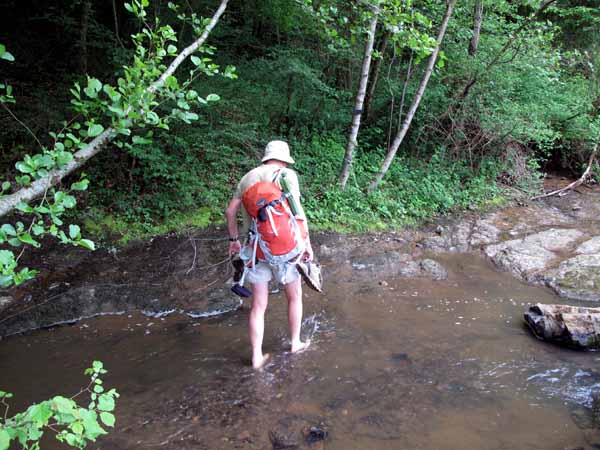
The path continued, up and down in the woods. We crossed a road at la Feyte and pressed on, trusting the signs until we joined a small descending road, also marked as a GRP (red and yellow).
This led us past Vitrat and down in a series of loops to a spur above the river, where the last stumps of the château of Crozant stuck out of the grass like rotten teeth.
Our morning’s walk had taken us from the department of Indre into that of Creuse and at the same time, from the Centre region into Limousin.
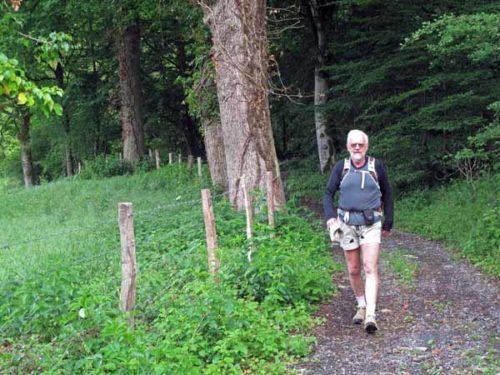
This border is more than just an administrative one – it marks the geological change from the limestone country of the western half of France to the granite of the Massif Central, and was also the linguistic dividing line between the Langue d’Oïl and the Langue d’Oc.
Crozant has another claim to distinction. It was the home of the painting movement known as the School of Crozant, started in the mid nineteenth century by members of the Barbizon school. As usual, George Sand was involved.
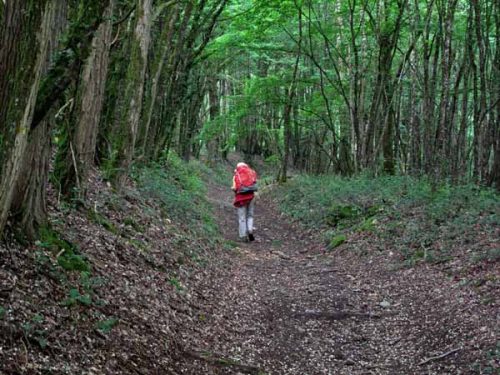
She had described the wild Creuse valley as “an enchanted wilderness” when she and Chopin explored it on a donkey in 1843. These painters, influenced by Constable and Turner, rejected the classical style and strove for freely painted scenes, mostly landscapes, prefiguring and including the Impressionists.
Indeed, one of their number was Monet, who lived for three months at Fresselines, a few kilometres upstream from Crozant, in 1889. The movement started to decline after the construction of the dam at Éguzon in 1926, which drowned the valley.
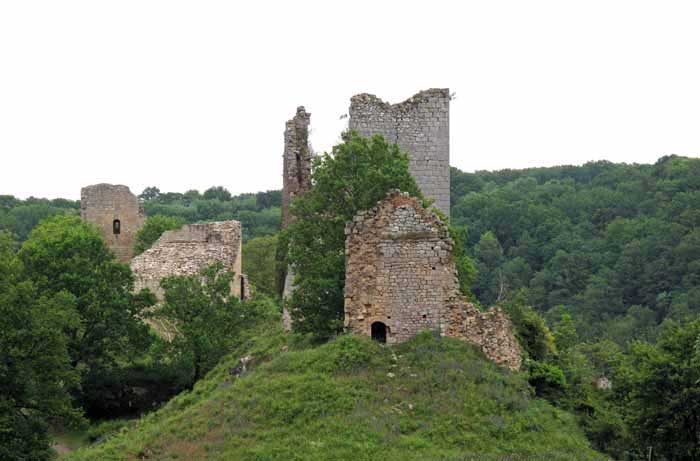
From the ruins of the château it was an uphill climb to the village, but fortunately there was a walkers’ short cut that got us there in short order, although gasping for breath.
It was easy to see why Crozant had been occupied since long before the Romans, with its strategic position on a promontory between the two valleys of the Creuse and its tributary the Sédelle.
Past the church we came to the main square, an irregular expanse containing parked cars and a large Italian tourist bus, from which people were spilling. We went into the boulangerie for bread and pastries, as well as to ask where we could find a bar.
The woman said there were a couple of them round the corner, but that she could provide coffee if we liked. We did like, and had a second breakfast of brioche and croissants in a sunny corner of her shop.
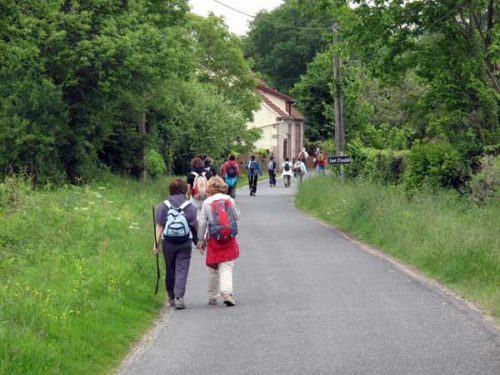
To leave the village we took the D72 along the ridge, past the other bars and some houses, then sharply down through woods to the Sédelle. Here we joined the GR for a few steps as we crossed the bridge, then left it again in favour of the pilgrim way, which continued up the other side of the valley and across farmland as far as la Chapelle-Baloue.
We were still on the little road, and as we marched along we noticed a throng of people ahead of us. They turned out to be the contents of the Italian tour bus that we had seen in Crozant, out for a stroll. Summoning up our rusty Italian, we had a lively chat with them.
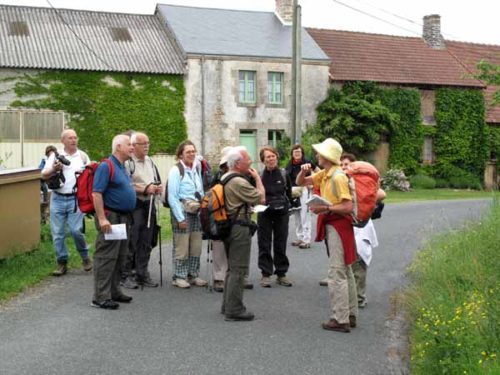
“We are false pilgrims”, they laughed, “We walk little and eat much!” We assured them that we ate much too. Their bus was coming to pick them up at la Chapelle-Baloue, and soon it rolled past us as we forged ahead.
The village consisted of a line of houses on a high spine, reached by a switchback street, but before we got there we were gratified to see, at the crossroads below, a hand-written sign for a café on the gate of an old stone house. We entered to a tumult of barking from a pair of miniature dogs, whose owner hurried over to welcome us.

Tables were set in the courtyard and we had coffee under an umbrella. Our hosts were three ageing British blondes who had bought the place recently. They were disappointed when we declined a full lunch menu, but bustled about eagerly, getting in each other’s way, to provide the coffee.
Climbing up to the village proper (where we waved to the Italians as they sailed off in their bus), we continued uneventfully along the deserted D72 through open fields, following the pilgrim signs.
After a while we stopped on the grassy verge near Pot Bouché for lunch and were passed by a pair of heavily-laden cyclists who were too exhausted even to wave, although it was the gentlest of landscapes.

We thought this rather rude. There is a code of comradeship among walkers and riders that demands at least a wave.
Further along, the GR came in from the left and joined us for a few metres before charging off in the direction it had come from, a good example of why no sane person walks the GR without modifying it. Just before Saint-Germain-Beaupré it sidled back onto the road and we kept going, pilgrimage and GR together for once.
After the village we left the road on a fine straight dirt track over rolling farmland, which would have been delightful except that our blisters were starting to dominate our thoughts.
As we descended towards le Puyrolland beside a wood, we noticed a sort of letter box and a rustic seat half hidden in the shrubbery. On the letterbox was written “Ultreia!”, the rallying cry of the pilgrims, and inside was a visitors’ book, in which we wrote.
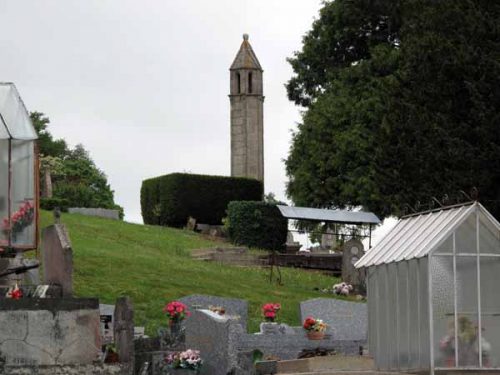
In the centre of the village of Saint-Agnant-de-Versillat was a large school with a series of doors opening onto a paved area near the street. We sat on the steps in front of one of the doors to attend to our feet.
Keith’s toe was a mass of bleeding flesh, hideously painful, and I had a sort of blister lake under the whole of the ball of my foot. The more we sat, the worse we felt. Just then a teacher came and kindly suggested that we move to a different doorway, as her kids were about to erupt out of this one, and we got out of the way just in time.
When we finally hobbled away, we were both in sandals in the hope of lessening the pain. It seemed worth a try. At the graveyard we admired the twelfth-century lantern of the dead, with its slitted top through which benedictory lamplight once shone down on the souls in residence.
We followed the GR, a farm track past a pond, and then took a short cut to avoid a senseless loop, hitting the bitumen again at l’Aumône. Soon we were on the outskirts of the big town of la Souterraine, our destination for the night, and it was beginning to rain, but we were not worried.

We knew that the camping ground was to the east of the centre, on an artificial lake, and that it had a restaurant and a bar, so we turned off the main road (as did the GR) and headed straight for it.
Sure enough, as soon as we rounded the lake, we saw the big cheerful sign -“Bar Restaurant” shining through curtains of rain. Our feet were saturated in their sandals but we looked forward to a cosy evening of drinking and dining.
Having signed up in the office and handed over €9.20,we asked when the restaurant would be open, and were told that it was closed for the next several weeks, having recently been sold. Suddenly everything changed. We had no food except for the leftovers from lunch.
The best idea would be to go to a hotel in the town, but the nearest one was two kilometres away, at the station, and Keith’s foot was so painful that he could barely walk at all. We had no choice but to stay where we were.

We huddled in the laundry for a while, until a break in the weather allowed us to dash out and put up the tent on an unkempt patch of grass. Then we found another shelter – a sort of concrete bunker under the laundry, used for games, with a few iron tables and chairs stacked in a corner.
It was already occupied by another walker, a weatherbeaten Belgian woman who seemed to think it was perfectly normal to be spending the evening in these dismal surroundings. She pulled out a heel of black bread and a tin of sardines, while we found some stale baguette, a bit of sausage, cheese and a tin of mackerel.
“This will pass”, we repeated to each other as we lay shivering in our sleeping bags with all our clothes on and the rain drumming down relentlessly all night.